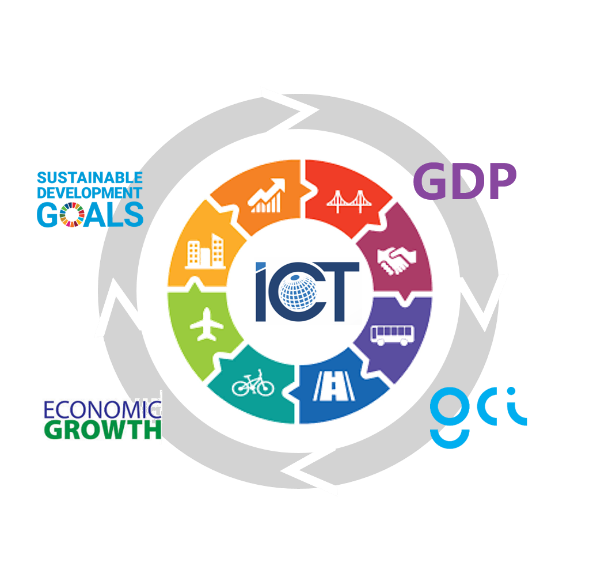Produkte, Lösungen und Services für Unternehmen
Smartphones, PCs & Tablets, Wearables, mobiles Breitband und mehr
Über Huawei, Nachrichten, Veranstaltungen, Brancheneinblicke und mehr

Advanced ICT and digital transformation programs are becoming game-changers and top priorities for nations eager to boost economic growth and industrialization, reduce poverty, and improve people’s lives and well-being.
Indeed, the use of digital technology is driving innovation and progress in almost all key sectors of the economy, including health, energy, transportation, agriculture, education, and social services.
While correlation between ICT and national GDP has been heavily researched — and indeed proven — for decades, ICT has extended beyond only mobile and fixed broadband Internet availability, to include advanced technologies such as cloud computing, Artificial Intelligence (AI), Internet of Things (IoT), and big data enablement.
If we think in terms of GDP, the magnitude of how ICT technologies impact the economy depends on variable parameters, such as the type of technology, the region and industry segment, the country, collaborations, policies and regulations.
In addition to this strong correlation between ICT and GDP, other key measurements have emerged over the years, such as Huawei’s Global Connectivity Index (GCI) and Sustainable Development Goals (SDGs) as defined by the United Nations (UN).
Indeed, new ICT opens an incredible path to accelerate the progress of the UN’s SDGs. Several reports and detailed research have already provided in-depth analysis, correlating a nation’s ICT score, its GDP, and progress toward the UN’s SDGs, including the use of AI and IoT.
To reiterate the point: such analysis reveals that SDGs are directly — and strongly — linked to ICT. Going further, some specific SDGs are likely to benefit the most from improvements in ICT, namely: SDG 3, Good Health and Well-being; SDG 9, Industry, Innovation and Infrastructure; SDG 5, Gender Equality; SDG 11, Sustainable Cities and Communities; and SDG 7, Affordable and Clean Energy.
Whichever index is used to measure the impact of ICT on GDP, all roads lead to Rome: advanced ICT is driving economic growth as well as improving people’s lives and overall well-being.
This article, however, focuses on Huawei’s GCI and how it can impact key national development areas such as SDG 3 (health and well-being).
The GCI index has emerged over the last five years as a comprehensive guide to gauge a nation’s status in ICT infrastructure investment, adoption, experience, and future potential as the world moves toward a digital economy.
The GCI compares and tracks the progress of 79 nations using 40 indicators across various stages of progress. It also takes into consideration social and political factors as well as a nation’s level of competitiveness and its economic growth.
To take a concrete example, in the latest GCI report, a one-point increase in GCI correlates to a 2.3% increase in economic productivity, a 2.1% increase in competitiveness, and a 2.2% increase in innovation.
In 2019, the GCI report expanded to cover “intelligent connectivity” in order to help policymakers understand the growing influence of AI on the global economy.

Intelligent connectivity is defined as the powerful convergence of broadband connectivity, cloud, IoT, and AI, which represents the next stage of digital transformation .
The expansion of ICT into the world of science and medicine has resulted in various innovations that have improved the medical field, not just in diagnoses and treatment, but also in communication and informatics management.
AI and intelligent connectivity might well be the next step for the world’s social healthcare services by augmenting the work of skilled medical specialists. Indeed, the GCI report offers examples: for instance, in terms of diagnostic accuracy, the world today faces a shortfall of seven million doctors and nurses, a situation that particularly affects rural areas and developing countries with rapid population growth.
Taking a step back, the challenges facing doctors and other healthcare professionals can be overwhelming; for example, managing massive volumes of paperwork, which limits face-to-face time with patients; keeping up with the latest research; rising costs; and the increasing likelihood of errors.
Intelligent connectivity, however, enables innovative new technologies such as virtual nurses, health assistants, AI-based cameras, and automated diagnoses and treatment. These new capabilities have the potential to revolutionize the practice of medicine.
GCI 2019 provides a concrete example that demonstrates how intelligent connectivity and AI are opening the way to new screening tools that ultimately save lives in the fight against diseases affecting millions of people around the world.
According to the World Health Organization (WHO), cervical cancer is the fourth most common cancer in women. Early diagnosis is critical to surviving the disease, yet the availability of the tests — which are carried out during a pelvic examination — is limited by a shortage of licensed pathologists who can conduct screening. With a high incident rate for the disease, China suffers from a shortage of pathologists: 90,000, according to one 2018 study. In an effort to combat this problem, a Chinese medical diagnostic test company has developed an AI-assisted test that is over 99% accurate yet costs just one-tenth of — and takes a fraction of the time it takes to conduct — a traditional test.
To train, validate and test the AI, developers fed it with 32,000 samples collected from over 43 million cervical screenings. While pathologists on average spend six minutes examining samples under a microscope during a traditional test, the new AI-assisted test takes just 36 seconds, representing a 90% improvement.
Buoyed by its success, the diagnostic firm is now exploring applications for the technology in pathologies for the digestive system, kidney, blood, and breast.
Intelligent connectivity creates most value through collaborative ecosystems, employing AI, cloud services, and IoT to expand the relation between the volume and quality of available data. When more relevant data and higher volumes of high-quality data are accessible for AI to analyze, intelligent connectivity can deliver solutions that solve very real-world problems.
Yet for all of this to work, there also has to be solid collaboration among parties, ICT technology providers, academic researchers, policymakers, regulators, and industrial sectors.